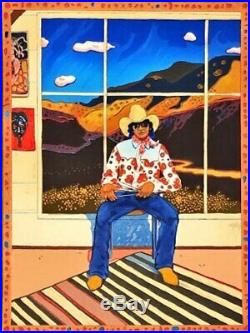
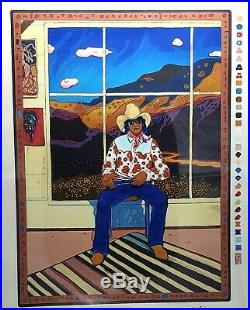
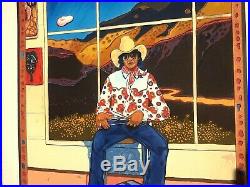
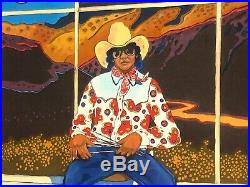
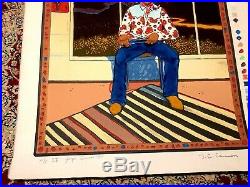
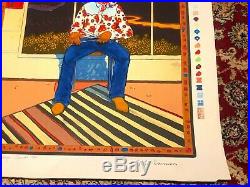

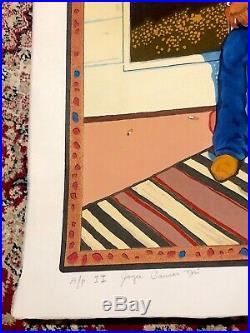
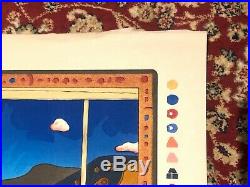
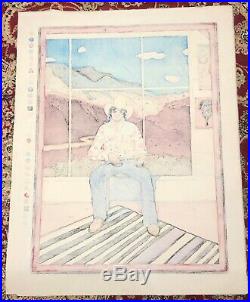
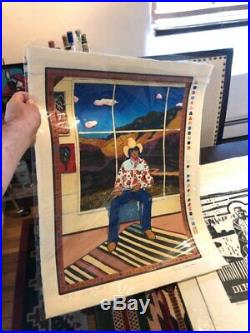
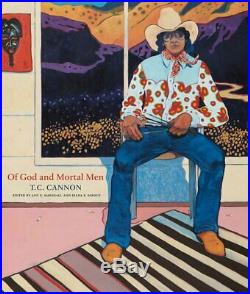
Cannon rocketed to fame along with fellow Indian artist, Fritz Scholder, in the Smithsonian Institutions 1972 exhibit Two Artists which forever changed everyones idea of what American Indian art could be. This unique original Japanese style woodblock print measures 25 x 20 and is in very good original condition for being around 40 or more years old. The print is signed in the woodblock by the artist as well as signed by T. S only living heir, his sister, Joyce Cannon Yi. Joyce is the executor of the T. Cannon Estate, who is also the artists sister and sole surviving family member. Joyce Cannon Yi is widely considered to be the official authoritative last word on the authenticity of T. The Print is unframed and comes in a protective plastic sleeve. It has been owned by the estate only and never been framed. Cannon was born in 1946 in Lawton, Oklahoma. He attended public schools in Gracemont, Oklahoma from 1955-64. He then had two years at the Institute of American Indian Arts in Santa Fe. While there he worked with Fritz Scholder and learned much from him. In 1971 Cannon enters Central State University in Edmond, Oklahoma, where he graduated three years later. Painting and Graphics by TC Cannon, is the first major exhibit for Cannon and is shown at the Southern Plains Indian Museum, arts and crafts center in Anadarko, Oklahoma. In 1972 the Smithsonian Institute honored Cannon and Fritz Scholder with a two-man show at the National Collection of Fine Arts in Washington D. Cannon is now established as an artist of national note. In 1974 Cannon makes his permanent home in Santa Fe, New Mexico. In 1975 Cannon is invited to become part of the famous artist -in- residence at Dartmouth College. During this year he begins to plan collaborations with Japanese master woodcutter Maeda and master printer Uchikawa. This relationship, which continued until the time of his death, resulted in a publication of what is known as the Memorial Woodcut Suite. His artistic works, in conjunction with those of Fritz Scholder (Luiseño) and Oscar Howe (Lakota), represent the turning point of Indian painting in postWorld War II America. These three artists’ styles represent a shift from the earlier flat, two-dimensional traditional painting on paper and canvas surfaces, which presented little modeling and static images of people, land, and animals. Cannon was a student at the Institute of American Indian Arts in Santa Fe, New Mexico, when he and his instructor, Fritz Scholder, recast the idea of the “Indian” into one that represents an artistic vision of people within the context of both traditional and contemporary culture. Cannon was the youngest of the three great painters, and his war experience, which influenced his work, came in Vietnam in the U. Army 101st Air Cavalry. At the Institute in Santa Fe he developed an intellectual curiosity that led him to read philosophy, world literature, poetry, and art history, and he was fascinated by music. He finished a bachelor of arts degree at Central State University (now the University of Central Oklahoma) in Edmond in 1972. Cannon’s signature works represent an incorporation of European and American painting styles with that of Indian culture. For example, Beef Issue at Fort Sill (1973, acrylic on canvas) presents brilliant colors, a mushroom-shaped cloud, and a Matisse-like composition of space that is divided into grids of right-parallel squares that run off the canvas. The startling images of two women carving up a prone beef carcass, with a dog on either side, represents the new look of Indian painting. The women are without facial features, and the dogs and dead animal are indicators of a time in both the present and the past. Until his untimely death in an automobile accident on May 8, 1978, near Santa Fe, New Mexico, T. Cannon continued to paint on both canvas and murals and also continued printmaking and writing poetry. His works are held by the Gilcrease Museum in Tulsa, the Southern Plains Indian Museum in Anadarko, the National Cowboy and Western Heritage Museum in Oklahoma City, the Institute of American Indian Arts in Santa Fe, and numerous private collections. Cannon is regarded as the most eloquent and innovative of the Native American Artist, who helped change the direction of the traditional Indian art to the New Wave movement that characterizes that Genre today. The item “T. C. CANNON Self Portrait Original Japanese Woodblock Print (Artist Proof)” is in sale since Sunday, February 2, 2020. This item is in the category “Art\Art Prints”. The seller is “stressfreeg” and is located in Taos, New Mexico. This item can be shipped to United States.
- Size: Medium (up to 36in.)
- Artist: T.C. Cannon
- Style: Contemporary Native American
- Listed By: Dealer or Reseller
- Printing Technique: Woodblock Printing
- Quantity Type: Single-Piece Work
- Medium: Woodcut & Block
- Date of Creation: 1970-1989
- Country/Region of Manufacture: United States
- Provenance: Ownership History Available
- Year: 1977
- Features: Signed
- Tribal Affiliation: Kiowa
- Origin: Estate
- Width (Inches): 20
- Color: Multi-Color
- Subject: Portrait
- Artisan: T.C. Cannon
- Modified Item: No
- Originality: Original
- Height (Inches): 25.5
- Print Surface: Paper
No comments